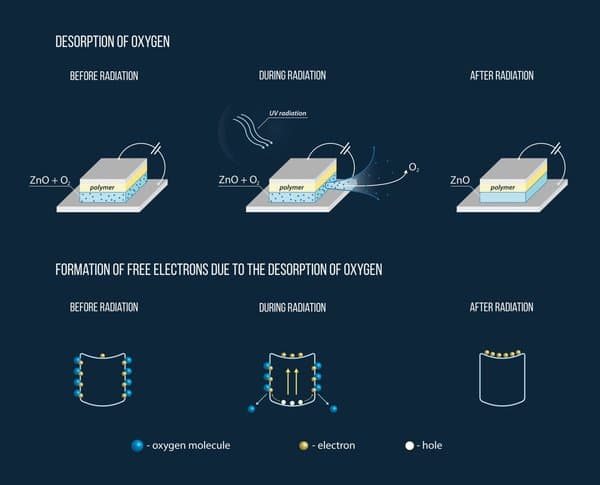UV Treated Photodetectors To Empower Mobile Cameras Very Soon
By far, the use of mobile cameras has improved and significantly forced the population to dive into the gadget flow. Whether you are a geeky developer or some layman, you probably think twice before buying a smartphone. And most of the time, the mobile camera is on the top of the list of your concerns. It has been more than a decade since we were gifted a mobile camera from the tech giants. And yet, the technology we worship, hits saturation making us greedy for something new, something better every day.
Assuming all the electronics engineers are familiar with the term photodetector, let us directly get involved with the news in our hand. Researchers at Moscow Institute Of Physics and Technology (MIPT) with their colleagues hailing from China and Saudi Arabia have managed to wash photodetector with UV light, making it a high bandwidth device. These photodetectors are one of the most valued parts of the camera module, generally, accept certain narrow bandwidth that complicates the procedure. With the new treatment, the devices are supposed to work in the extended spectra.

Technical Jargon Involved
Vadim Agafonov, head of the Molecular Electronics Center at MIPT responded, the contributors from Changchun Institute of Applied Chemistry (China) and King Saud University (Saudi Arabia) applied their efforts to go deeper into polymer photodetectors depended on the internal photoelectric effect. He added, having more advantages including low cost, simpler manufacturing compared to its inorganic counterparts, it was seen the polymer-made device gained its sensitivity after UV-treatment.
In the experimental set-up, a polymer photodetector combined with zinc oxide (ZnO) nanoparticles was exposed to the UV ray for about 30 seconds. The noted result proved that the output device was supportive of a broader spectral response and a maximum external quantum efficiency (EQE) of 140,000% was attained in comparison to 30%, before treatment. Regulating some more parameters involved with the process, a cheaper and better “broadband†solution could be achieved out of a polymer photodetector. The results have been recently published in the Advanced Functional Materials.
Source: Photodetectors “see” more after UV light treatment — News MIPT
Assuming all the electronics engineers are familiar with the term photodetector, let us directly get involved with the news in our hand. Researchers at Moscow Institute Of Physics and Technology (MIPT) with their colleagues hailing from China and Saudi Arabia have managed to wash photodetector with UV light, making it a high bandwidth device. These photodetectors are one of the most valued parts of the camera module, generally, accept certain narrow bandwidth that complicates the procedure. With the new treatment, the devices are supposed to work in the extended spectra.

Technical Jargon Involved
Vadim Agafonov, head of the Molecular Electronics Center at MIPT responded, the contributors from Changchun Institute of Applied Chemistry (China) and King Saud University (Saudi Arabia) applied their efforts to go deeper into polymer photodetectors depended on the internal photoelectric effect. He added, having more advantages including low cost, simpler manufacturing compared to its inorganic counterparts, it was seen the polymer-made device gained its sensitivity after UV-treatment.
In the experimental set-up, a polymer photodetector combined with zinc oxide (ZnO) nanoparticles was exposed to the UV ray for about 30 seconds. The noted result proved that the output device was supportive of a broader spectral response and a maximum external quantum efficiency (EQE) of 140,000% was attained in comparison to 30%, before treatment. Regulating some more parameters involved with the process, a cheaper and better “broadband†solution could be achieved out of a polymer photodetector. The results have been recently published in the Advanced Functional Materials.
Source: Photodetectors “see” more after UV light treatment — News MIPT
Replies
You are reading an archived discussion.
Related Posts
Professor Arun Kota, from the School of Biomedical Engineering at Colorado State University has developed a 'super tape' that sticks to almost any surface and offers liquid repelling properties to...
So the rumours are true! Xiaomi’s upcoming device, Mi Note 2 is expected to feature two-sided dual display. The Company, recently, confirmed it on its twitter handle and also released...
Quote:
Your education doesn’t have to stop once you leave school. We’ve put together a curriculum of some of the best free online classes available on the web this fall...
How to identify the Stainless steel Grade by its composition ?
Example:
Carbon: 0.24 MAX
Silicon: 0.95-1.25
Manganese: 0.5-0.9
Antimony: 0.02-0.09
Aluminium: 0.35 MAX
Phosphorus: 0.015-0.02
Sulphur: 0.02 MAX
Others:...
Fossils of Diatoms, a single celled algae, may now be used in the production of anodes for the lithium-ion batteries that power electric cars. Team of researchers from Bourns College...
